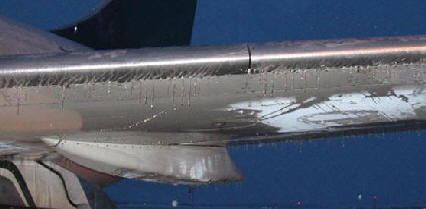
NEWSROOM
 |
NEWSROOM |
|
|
|
|
|||
|
FAA Bans
Takeoffs With “Polished Frost”
By Mike Mitchell |
||||
 |
November 30, 2009
- The FAA is removing certain provisions in its regulations that allow
for operations with “polished frost” (i.e., frost polished to make it
smooth) on the wings and stabilizing and control surfaces of aircraft.
The rule is expected to increase safety by not allowing operations with
“polished frost,” which the FAA has determined increases the risk of
unsafe flight.
The Federal
Aviation Administration is increasing the safety of winter flying by
prohibiting takeoffs with “polished frost” frost buffed to make it
smooth — on the wings, stabilizers and control surfaces of several
classes of aircraft.
|
|||
|
The FAA already prohibits major and regional air carriers from operating
with polished frost. Frost can affect the aerodynamics of wings and
control surfaces, and the safest action is to completely remove it.
Previous FAA guidance recommended removing all wing frost prior to
takeoff, but allowed it to be polished smooth if the aircraft
manufacturer’s recommended procedures were followed. But manufacturers
never published standards of acceptable smoothness for polished frost,
and the FAA has no data to determine exactly how to polish frost to
satisfactory smoothness.
“The FAA has advised pilots not to take off with frost or ice
contaminating their wings for years because it made good sense,” said
FAA Administrator Randy Babbitt. “Now, it’s the law.”
The new rules include four alternatives to removing frost that operators
may consider:
• using wing
covers to prevent frost accumulation on wings
• waiting for
frost to melt
• storing the
aircraft in a heated hangar • deicing the wing surface. |
||||
|
The new rules also clarify that affected aircraft must have functioning
deicing or anti-icing equipment for flights under Instrument Flight
Rules into known or forecast light or moderate icing conditions, or
under Visual Flight Rules into known light or moderate icing conditions.
The FAA published an NPRM in the Federal Register on May 8, 2008 (73 FR
26049). The NPRM proposed to remove language permitting pilots to
takeoff with polished frost adhering to the wings or stabilizing or
control surfaces. The NPRM also proposed to restructure and to clarify
the provisions of those sections. The comment period closed on August 6,
2008.
As discussed in the NPRM, the FAA has recognized that adverse
aerodynamic effects on lifting surfaces begin as soon as frost begins to
adhere to the surfaces. For example, the presence of frost may: (1)
reduce a wing’s maximum lift by 30 percent or more; (2) reduce the angle
of attack for maximum lift by several degrees; (3) increase drag
significantly; and (4) change unexpectedly the aircraft’s handling
qualities and performance.
The severity of these adverse aerodynamic effects varies significantly depending on: (1) the thickness, density, and location of the frost; (2) the degree of the surface roughness; and (3) the location of the roughness relative to the surface leading edge where significant variations may occur in the local airspeed and surface air loads. |
| ©AvStop Online Magazine Contact Us Return To News |